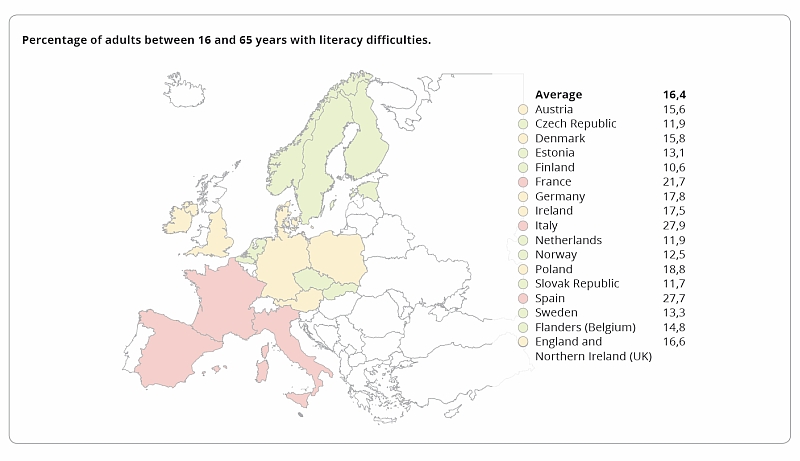Since the invention of the printing press 500 years ago, reading has become an increasingly important skill.
Education, politics, science and art are based on this ability. Just like our professional, leisure and everyday life.
Actually, we thought that due to the general compulsory school attendance there would be no more illiteracy.
But the fact is that one in five people between 15 and 65 in Europe cannot read well enough to understand the meaning of a text.
So there are almost 90 million so-called “functional illiterates” throughout the EU.
That is 20 % of the total population!
Not being able to read well enough has many disadvantages for those concerned:
At work, in their circle of friends, when bringing up children, in health and, of course, in social and political participation.
In addition, this causes an economic damage of 350 billion euros per year (only in Europe).
This is because the lack of skilled workers, unemployment, crime, health risks and necessary social benefits increase due to this problem.
So in text AND speech. Smartphones and voice assistants make it possible!
LISTEN TO VOICE ASSISTANT READING OUT THIS BLOG

In Europe, between 10.6% (Finland) and 27.9% (Italy) of citizens cannot read sufficiently! Source: ENINET
And how much do those who are good at it read?
And not just posters, street signs, short messages or instructions for use. But newspaper articles and books!
Sure, there are still real bookworms. Even among children and young people.
But reading is still falling behind as a popular leisure activity. It makes no difference whether the reading is offered as e-book, online contribution or in printed form.
Videos, audio, photos, emojies and voice assistants are simply considered more modern. And are also faster and easier to consume.
In terms of user-friendliness, i.e. “usability”, reading texts simply cannot compete with these media.
Marketing messages only in written form hardly reach many target groups anymore.

The proportion of those who do not like reading rose from 11 to 26 percent. Older people clearly prefer to read more than the young, women more than men. Source: APA 2016
So it is a fact that – for whatever reason – fewer and fewer people can or want to read.
And we therefore do not reach these customers with our texts at all!
Thus it is important to create a way to ensure that our messages reach these people.
A perfect solution are voice assistants, as with Siri, Alexa or Google Maps. Text-to-speech (TTS) and speech-to-text (STT) software make it possible.
Using recordings of professional speakers and algorithms for pronunciation and intonation, a TTS can read out any text, word for word.
Hands and eyes remain free while listening! This is simply super comfortable in many situations.
This is why the use of voice assistants is rapidly increasing among young and old.
Another reasons is that the quality of TTS has improved significantly in the meantime.
The pronunciation is clearer and more lively. Listening has become much more pleasant.
This is ideal for cookbooks, brochures, user manuals, packaging or advertising messages.
All that is still needed for this read aloud service is an easy-to-use and of course free smartphone app for the end user.
Reading a code or NFC tag and listen. Problem solved!
LISTEN TO VOICE ASSISTANT READING OUT THIS BLOG

To read AND to listen – this is good for the information reach and super convenient for all users
Why Storytelling with Voice Assistants is a perfect combination
read moreWhy audio communication is the best choice for Storytelling and what you need to consider when writing audio texts.
read moreFunctional illiteracy affects around 100 million people in the EU. Why is this a problem? And what solutions are…
read moreFind out, what customer centricity really means, why it is a must for success and which mistakes you should avoid.
read moreRead the latest SpeechCode blogs and news on the topics Universal Design, Customer Focus and Digitalisation.
read more